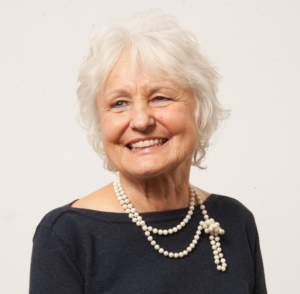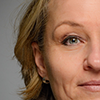Dr. Gundl Kutschera – Sociologist, Psychotherapist, Health and Clinical Psychologist, Trainer, Coach, Author, Founder of Kutschera Institute, Developer of the Kutschera-Resonance® method
“Resonance describes the balance between control and letting go, conscious and unconscious, the needs of others and one’s own.“
You can already see it in her credential list: Gundl Kutschera’s expertise is purely self-evident. As the founder and owner of Kutschera Institute, she manages and runs an organisation with a number of handpicked consultants, spanning six countries – and pursuing one essential goal: to teach Self and Social Competence for better inter- and intrapersonal communication. Never would she say about herself that her knowledge, skills and know-how were limitless. However, she would certainly claim that with regards to the human brain – and the fact that we are only using 2% of its capacity consciously. The remaining 98% are used ‘anyhow’ – and often in an offending way to others. Not because we cannot act otherwise. It is because we have never been taught and don’t know any better.
With her lifework, the Kutschera-Resonance® method, Gundl and her organisation have conducted numerous projects in the areas of children and youth, parents, school, health, business and regional development and given tools for better communication to thousands of managers, workshop participants and coaching clients.
Gundl’s vision: seeing the holistic thinking and learnings of Self and Social Competence as a compulsory subject implemented in schools, universities and research curriculums.
Gundl, you are the author of several books, lecturer and university lecturer in Europe and the US. You were the first NLP instructor in German-speaking countries. What was at the beginning of your occupational history?
My interest for ‘all things relations and relationships’ started when I was a child really. In post-war Austria, I learned from a very young age that the ‘strangers’, the Allied Occupation soldiers, were no enemies to us. They were decent human beings doing a job that they probably didn’t bargain for in their young lives, playing with us children and letting us ride on their tanks. My reality of British soldiers was not that of fear, yet an experience of coexistence and interaction, and I probably started to be interested in how human beings are related and communicate with each other back then.
I can still recall the feeling of inner conflict – sensing my mother’s fear of the situation and at the same time my own perception of an environment that was friendly, helpful and safe.
Later, I decided to study Sociology at University – I wanted to learn about social behaviour, human interaction, prerequisites, processes and consequences of human coexistence and how we can make practical use of systems and theories. For me, existing concepts had to ‘come alive’ in order to make them useable for people.
How would you best describe the Kutschera-Resonance® method?
The method developed over the course of many years (its denomination stems from physics, describing the interaction and interdependence of systems and their shift after extrinsic impact). After having worked in Germany at the Max Planck Institute for several years (Child Psychiatry and Social Psychology, editor’s note) and later in the US with the likes of John Grinder, Richard Bandler, Milton Erickson and Virginia Satir as well as in the field with psychotic and addicted adolescents, the Resonance® method eventually emerged. And even though I had learned from the greatest teachers in the fields of psychology and communication, for me, there was still something missing: a more explicit strategy oriented towards solutions (as opposed to ‘away from problems’), a concept for an inner source that we have at our disposal no matter how difficult the external circumstances are as well as an understanding and the integration of the multiple roles everyone has in their life.
Whenever questions opened up in my daily work with children and their families, I updated and further developed my method. Ultimately, the aim was – and still is – to effectively apply the findings of modern brain research in practice, embedded in an ethical and holistic frame that is needed in order to give the concept its morally correct orientation and insist on the responsibility everyone has with their actions.
The Resonance® method is about good communication and healthy relationships and how they can be made learnable and teachable. It is about finding and developing one’s own individual resonance – their ‘flow’, if you like – and learn how to authentically live this quality in interaction with oneself and others in as many situations as possible – in personal life and in the workplace. It is about embracing that otherness is wealth.
You can imagine it like an orchestra: the best results emerge when each musician plays their own instrument to the best of their ability – and at the same time listens and communicates with the other orchestra members, as well as with the audience. The more natural, the better the outcome will be. All it takes is awareness, volition, attitude, listening skills and practice. This holistic concept of an orchestra is the aim of my work. It means being the maestro of your own orchestra, bringing everything together that is important in your daily life – work, family, friends, hobbies – in beautiful harmony.
Your institute is active in several countries (Austria, Germany, Switzerland, Romania, Russia, Jordan). Can the Kutschera-Resonance® method be applied across different cultures?
The beauty of the method lies in its universal applicability. Exercises and tools are given subject matter free, and everyone ‘fills’ them in their own way, with their own substance. In our courses and trainings, we highly emphasise individual responsibility.
You have been a member of the Austrian Ski Squad for many years. Are there any ‘success factors’ in sports that you have transferred to your daily life?
Sport motivates people to explore their limits, and skiing was my way of doing it. It was an area where I could test what else was possible and how I could achieve even more. I was filled with excitement and joy, my primary impulses for wanting to succeed. I felt the same in my professional career: excitement when it came to not just exploring limits, but actually shifting them.
Can you give us an example?
My daughter Stefanie, after having suffered a lack of oxygen during birth, had been given up by the doctors, labelled as someone who would never be able to walk nor speak. I did not accept their diagnosis and practised with her – every element of movement and every tone, every day, up to 10 hours. Today, Stefanie is one of our best trainers/coaches and living proof that we are the product of our decisions and actions, not our circumstances, and that everyone can use the brain in a new way and make the seemingly impossible possible.
You and your husband Walter (Nuclear physicist, editor’s note) have been married for nearly 60 years, you have 3 children and 14 grandchildren. What is your personal secret for a successful marriage – or a happy relationship in general?
Walter and I met through our sporting activities and used to practise rock climbing together, sometimes quite difficult climbs. Imagine you are hanging onto a cliff and totally depend on the person at the other end of the rope: you need a lot of trust to do that. There must also be absolute clarity about who leads and who follows – an order that can change with time or depending on the task on hand. We worked on these rules and went through ups and downs together. Trust and reliance are something that eventually became completely natural.
What has top priority in your life?
The wellbeing of my children and grandchildren. In fact, the wellbeing of all children of the world. I see them as the buds of today and the flowers of tomorrow.
How do you best recharge your batteries?
Personally, I love to dawdle, I love to have fun with others, and I am happy when I can be there for others. Above all, I like to focus on the day-to-day ‘moments of joy’. Moments of joy are not necessarily the big life-altering ones. It is the little moments every single one of us experiences on a daily basis: the sunrise, birds chirping in the morning, the curious and open-hearted eyes of a child, enthusiastically bursting out “Hello grandma!”.
Every moment can be a moment of joy. The question is: do we see them?
(published 16th April 2019)


